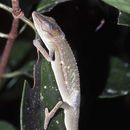Biology
(
Anglèis
)
fornì da Arkive
Chameleons are generally solitary, and move about on slender branches and twigs, gripping with their fused toes. The prehensile tail provides an additional 'hand' on this precarious walkway as they scan the surrounding area with their independently mobile eyes for prey (5).
In captivity, a Perinet chameleon fed on small insects and laid a clutch of three eggs, which were incubated at 23 degrees Celsius, but none hatched (3).
Conservation
(
Anglèis
)
fornì da Arkive
Habitat protection is likely to be the key to this species' long-term survival. As well as protecting primary forest, the Perinet chameleon's ability to inhabit forests subject to low level of human disturbance show that these areas are also worthy of protection. Its apparent preference, in at least some areas, for forest alongside rivers, highlights that rivers and their bordering forests should also be incorporated into future management and conservation programmes in Madagascar's rainforests (4).
Description
(
Anglèis
)
fornì da Arkive
Perinet chameleons are small and graceful reptiles (3), with smooth, vivid green skin (2), which can make them almost invisible in their lush, green habitat (3). The head is elongated (2), the body is slender, and the tail is long and tapering (3). Typically, a pale line runs along each side of the body (2). Three subspecies of Perinet's chameleon are recognised. Calumma gastrotaenia andringitraensis can be easily distinguished by the presence of a dorsal crest (a ridge of highly modified scales along the back), while C. g. marojezensis and C. g. guillaumeti both lack a dorsal crest but differ in the morphology of the hemipenis (2). Male Perinet chameleons can be distinguished from females by, not only their larger size (3), but also the more pronounced casque (a bony head crest) and, where present, a slightly higher dorsal crest (2).
Habitat
(
Anglèis
)
fornì da Arkive
The Perinet chameleon inhabits primary forest and forest remnants, between elevations of 600 and 1,530 metres (2), particularly alongside rivers (4). It is known to dwell in shrubs and low trees (3).
Range
(
Anglèis
)
fornì da Arkive
Occurs in humid areas of eastern and central Madagascar (2) (3).
Status
(
Anglèis
)
fornì da Arkive
Listed on Appendix II of CITES (1).
Threats
(
Anglèis
)
fornì da Arkive
Many of Madagascar's chameleons are thought to be threatened by the continued fragmentation and degradation of the island's forests. Most chameleons cannot tolerate high levels of disturbance, such as burning, which destroys vegetation that the chameleons rely on to protect against predators and solar radiation, and reduces numbers of prey. However, it appears that many chameleons can tolerate low levels of disturbance, such as selective timber extraction (4).

